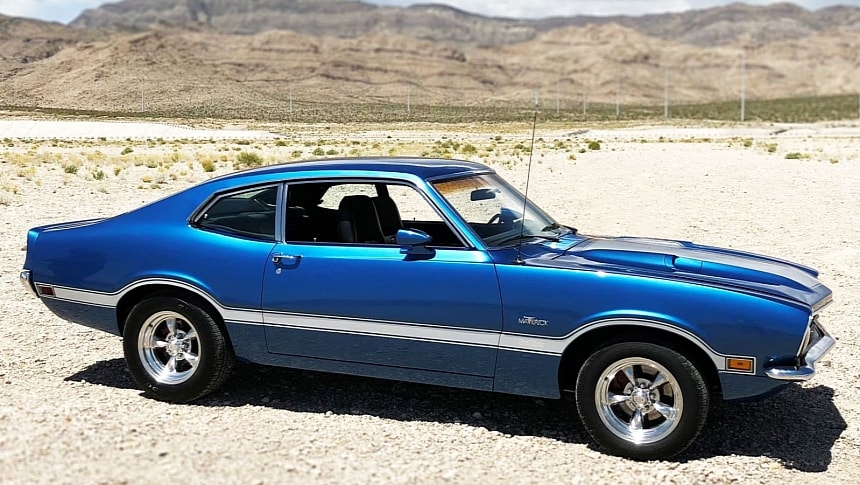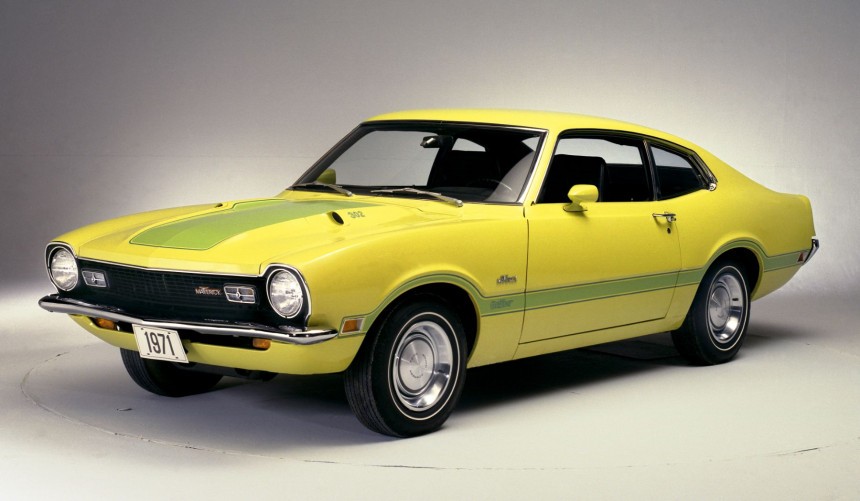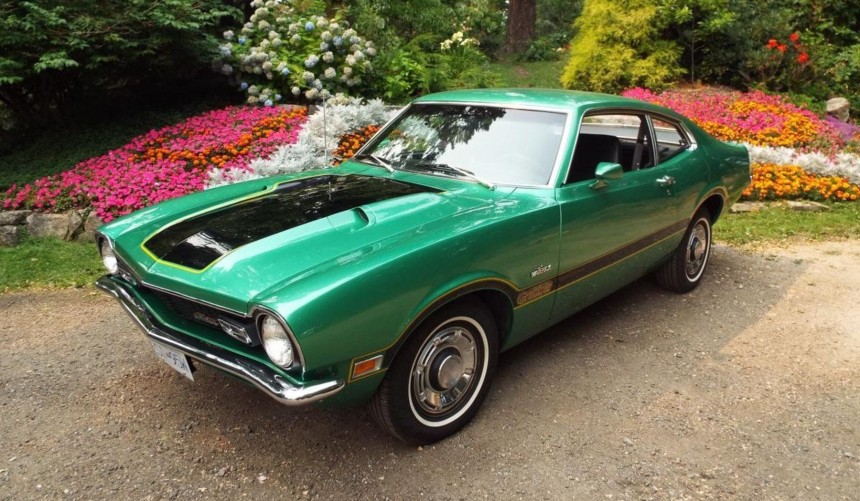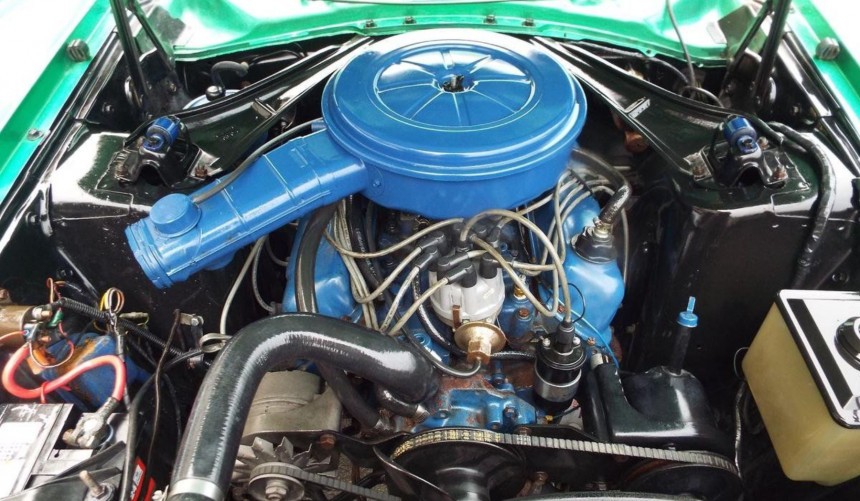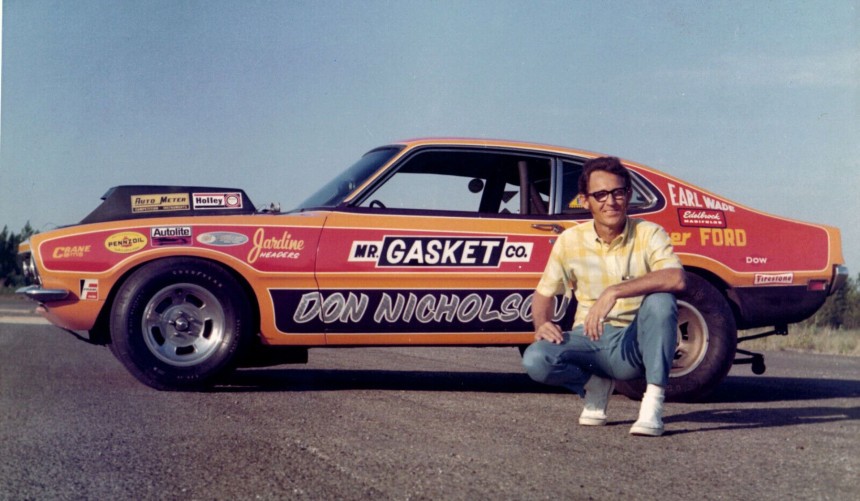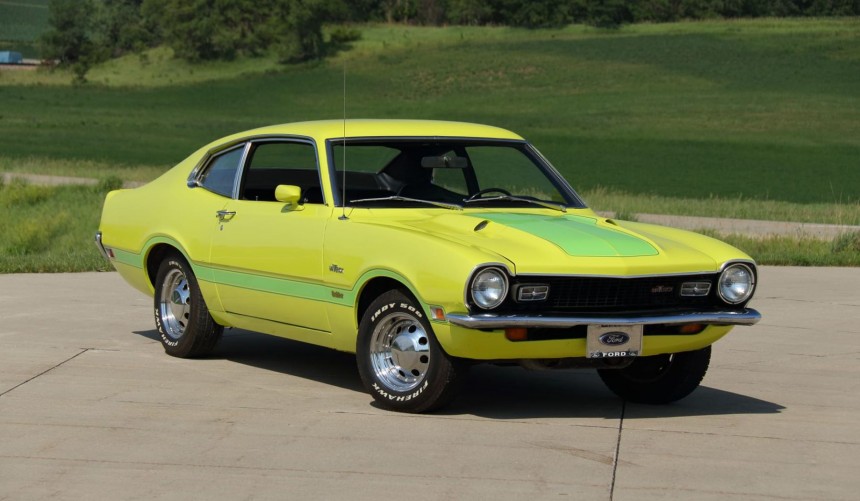Today, the Maverick is Ford's compact pickup truck offering, but back in the 1970s, the Maverick Grabber was a sporty two-door coupe that kept the muscle car flame burning during the dark age of performance.
During the 1960s, Ford rode the muscle car wave with might. However, by the early 1970s, that wave was about to crash into a proverbial breakwater of rising insurance rates, new government regulations, and a looming oil crisis.
Luckily, the corporation had an all-star lineup of managers, designers, and engineers who anticipated the abrupt end of all things performance-related, as well as the rise of cheap, fuel-efficient imports.
While the 1970 model year was the peak of factory-build performance in the muscle car realm, and the Blue Oval joined its rivals in releasing a series of highly potent models, it also introduced a new budget-friendly compact called Maverick.
Unveiled on April 17, 1969, as a 1970 model, the new car was marketed as the greatest Ford product to date in terms of price, reliability, and standard features.
The brainchild of John Naughton (then FoMoCo Vice President and Ford Division General Manager), the Maverick was initially available only as a semi-fastback, two-door sedan powered by a couple of inline sixes.
Since the compact third-gen Falcon was still in production, the new model was marketed as a subcompact import fighter, but once the Falcon became Ford's entry-level intermediate in the middle of the 1970 model year, the Maverick was repositioned as the corporation's compact offering.
Aimed directly at the Chevrolet Nova, the Dodge Dart, and the increasingly popular Japanese imports, the latest entry in the Blue Oval's lineup had a starting price of $1,995 ($15,858 in 2024 money).
Thanks to the very competitive price and the sales wizardry of Lee Iacocca, which included a very advantageous trade-in program, the Maverick was an instant hit.
During its debut year, Ford sold close to 579,000 units, a feat that almost broke the Mustang's first-year record of 619,000 cars.
Apart from the marketing campaign and attractive price, one of the main reasons for the Maverick's success was its sporty styling.
But Ford didn't rest on its laurels and infused additional sportiness into the lineup in the middle of the 1970 model year by adding a new package dubbed Grabber.
Initially, it was an appearance-boosting trim that added larger wheels and tires, a unique stripe package, and a new blacked-out grille. However, there were no real performance upgrades to match the muscly look.
Luckily, that changed in 1971, when, apart from a new rear spoiler and a deluxe steering wheel, the Grabber got a much-needed performance boost.
Encouraged by the huge sales figures of the first-year Maverick, Ford decided to add more power to the sportier Grabber and promote it to a separate model position within the Maverick lineup.
Thus, in 1971, the car backed up its muscle car looks with actual V8 power courtesy of a 302-ci (4.9-liter) small block tucked away under a new dual-scoop hood.
Though it was essentially the same 302 (marketed as a 5.0-liter) Windsor that powered a multitude of potent Ford muscle cars, the Maverick's version was equipped with a two-barrel carb and featured a modest 9:1 compression ratio to boost reliability and fuel consumption, but also keep emissions at bay.
Rated at 210 hp and backed up by either a column-shifted three-speed manual or a C4 three-speed automatic, the V8 made the 1971 Maverick Grabber twice as powerful as the 1970 1/2 six-cylinder-powered model.
In terms of stock performance, the Maverick Grabber was by no means a muscle car. It could accelerate from 0 to 60 mph (97 kph) in the mid-nine-second range and run the quarter mile in the mid-16s.
These figures were poor on paper, especially compared to big-block-powered intermediates. Nevertheless, the Maverick Grabber could be transformed into a legitimate muscle car by simply adding readily available aftermarket hardware like performance heads, a hotter cam, and an improved intake equipped with a four-barrel carb.
Adding a more capable rear-end to the mix meant even better performance, as evidenced by the multitude of Grabbers that became drag racing stars during the mid-1970s. Of these, the most famous became "Dyno Don" Nicholson's monster, which grabbed the Pro Stock title in 1971.
In 1972, performance dropped to 143 hp due to an 8.5:1 compression ratio that kept the engine emission-compliant. By 1975, the Grabber's last year on the market, the 302 reached an all-time low with only 129 hp on tap.
Nevertheless, the Grabber helped keep the muscle car flame burning during the onset of the Malaise era thanks to its compact size, low weight, and tuning potential.
From the middle of the 1970 model year to the end of 1975, Ford built 138,000 Maverick Grabbers.
Today, this handsome compact with muscle car aspirations is unfairly forgotten by many enthusiasts.
Therefore, surviving examples in terrific shape are rarely on any collector's list. That means an extremely well-kept, highly original 1971 example (the most coveted) is worth around $25,000, while a modified, fully restored version can be twice as cheap.
This makes the Grabber an excellent choice for those who want an affordable classic from the golden age of muscle cars.
Sure, it's not a legitimate muscle car in stock form, but it still can be easily transformed into one without spending a fortune on upgrades.
For more on what makes this underrated compact special, we recommend watching the YouTube video below by Lou Costabile.
Luckily, the corporation had an all-star lineup of managers, designers, and engineers who anticipated the abrupt end of all things performance-related, as well as the rise of cheap, fuel-efficient imports.
While the 1970 model year was the peak of factory-build performance in the muscle car realm, and the Blue Oval joined its rivals in releasing a series of highly potent models, it also introduced a new budget-friendly compact called Maverick.
A short history of the original Maverick
The brainchild of John Naughton (then FoMoCo Vice President and Ford Division General Manager), the Maverick was initially available only as a semi-fastback, two-door sedan powered by a couple of inline sixes.
Since the compact third-gen Falcon was still in production, the new model was marketed as a subcompact import fighter, but once the Falcon became Ford's entry-level intermediate in the middle of the 1970 model year, the Maverick was repositioned as the corporation's compact offering.
Aimed directly at the Chevrolet Nova, the Dodge Dart, and the increasingly popular Japanese imports, the latest entry in the Blue Oval's lineup had a starting price of $1,995 ($15,858 in 2024 money).
Thanks to the very competitive price and the sales wizardry of Lee Iacocca, which included a very advantageous trade-in program, the Maverick was an instant hit.
During its debut year, Ford sold close to 579,000 units, a feat that almost broke the Mustang's first-year record of 619,000 cars.
The Grabber package
But Ford didn't rest on its laurels and infused additional sportiness into the lineup in the middle of the 1970 model year by adding a new package dubbed Grabber.
Initially, it was an appearance-boosting trim that added larger wheels and tires, a unique stripe package, and a new blacked-out grille. However, there were no real performance upgrades to match the muscly look.
Luckily, that changed in 1971, when, apart from a new rear spoiler and a deluxe steering wheel, the Grabber got a much-needed performance boost.
Adding two more cylinders to the mix
Thus, in 1971, the car backed up its muscle car looks with actual V8 power courtesy of a 302-ci (4.9-liter) small block tucked away under a new dual-scoop hood.
Though it was essentially the same 302 (marketed as a 5.0-liter) Windsor that powered a multitude of potent Ford muscle cars, the Maverick's version was equipped with a two-barrel carb and featured a modest 9:1 compression ratio to boost reliability and fuel consumption, but also keep emissions at bay.
Rated at 210 hp and backed up by either a column-shifted three-speed manual or a C4 three-speed automatic, the V8 made the 1971 Maverick Grabber twice as powerful as the 1970 1/2 six-cylinder-powered model.
Keeping the muscle car flame burning on the drag strip
These figures were poor on paper, especially compared to big-block-powered intermediates. Nevertheless, the Maverick Grabber could be transformed into a legitimate muscle car by simply adding readily available aftermarket hardware like performance heads, a hotter cam, and an improved intake equipped with a four-barrel carb.
Adding a more capable rear-end to the mix meant even better performance, as evidenced by the multitude of Grabbers that became drag racing stars during the mid-1970s. Of these, the most famous became "Dyno Don" Nicholson's monster, which grabbed the Pro Stock title in 1971.
In 1972, performance dropped to 143 hp due to an 8.5:1 compression ratio that kept the engine emission-compliant. By 1975, the Grabber's last year on the market, the 302 reached an all-time low with only 129 hp on tap.
Nevertheless, the Grabber helped keep the muscle car flame burning during the onset of the Malaise era thanks to its compact size, low weight, and tuning potential.
The 1971 Maverick Grabber today
Today, this handsome compact with muscle car aspirations is unfairly forgotten by many enthusiasts.
Therefore, surviving examples in terrific shape are rarely on any collector's list. That means an extremely well-kept, highly original 1971 example (the most coveted) is worth around $25,000, while a modified, fully restored version can be twice as cheap.
This makes the Grabber an excellent choice for those who want an affordable classic from the golden age of muscle cars.
Sure, it's not a legitimate muscle car in stock form, but it still can be easily transformed into one without spending a fortune on upgrades.
For more on what makes this underrated compact special, we recommend watching the YouTube video below by Lou Costabile.
